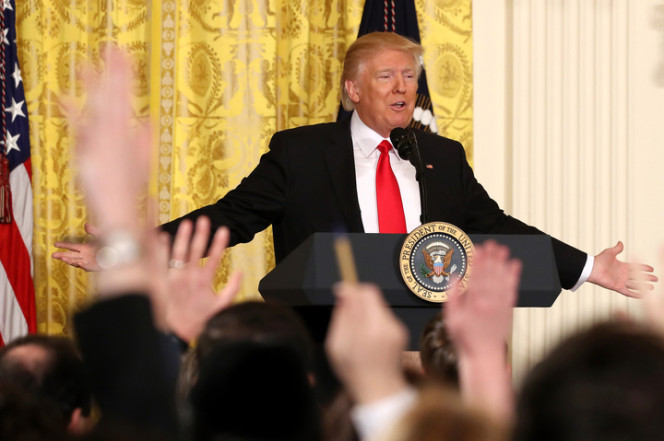
Sunday July 9, 2017
Since President Trump was elected, the media landscape has divided and hardened more than ever. Even the once-unimpeachable New York Times has been guilty of “fake news,” while on Tuesday CNN had to retract an article that slimed a Trump aide based on flimsy reporting. In April, The Post’s Michael Goodwin delivered this speech at a Hillsdale College National Leadership Seminar in Atlanta, analyzing how we got here — and how journalism can survive.
I’ve been a journalist for a long time. Long enough to know that it wasn’t always like this. There was a time not so long ago when journalists were trusted and admired. We were generally seen as trying to report the news in a fair and straightforward manner. Today, all that has changed. For that, we can blame the 2016 election or, more accurately, how some news organizations chose to cover it. Among the many firsts, last year’s election gave us the gobsmacking revelation that most of the mainstream media puts both thumbs on the scale — that most of what you read, watch and listen to is distorted by intentional bias and hostility. I have never seen anything like it. Not even close.
It’s not exactly breaking news that most journalists lean left. I used to do that myself. I grew up at the New York Times, so I’m familiar with the species. For most of the media, bias grew out of the social revolution of the 1960s and ’70s. Fueled by the civil rights and anti-Vietnam War movements, the media jumped on the anti-authority bandwagon writ large. The deal was sealed with Watergate, when journalism was viewed as more trusted than government — and far more exciting and glamorous. Think Robert Redford in “All the President’s Men.” Ever since, young people became journalists because they wanted to be the next Woodward and Bernstein, find a Deep Throat, and bring down a president. Of course, most of them only wanted to bring down a Republican president. That’s because liberalism is baked into the journalism cake.
During the years I spent teaching at the Columbia University School of Journalism, I often found myself telling my students that the job of the reporter was “to comfort the afflicted and afflict the comfortable.” I’m not even sure where I first heard that line, but it still captures the way most journalists think about what they do. Translate the first part of that compassionate-sounding idea into the daily decisions about what makes news, and it is easy to fall into the habit of thinking that every person afflicted by something is entitled to help. Or, as liberals like to say, “Government is what we do together.” From there, it’s a short drive to the conclusion that every problem has a government solution.
The rest of that journalistic ethos — “afflict the comfortable” — leads to the knee-jerk support of endless taxation. Somebody has to pay for that government intervention the media loves to demand. In the same vein, and for the same reason, the average reporter will support every conceivable regulation as a way to equalize conditions for the poor. He will also give sympathetic coverage to groups like Occupy Wall Street and Black Lives Matter.
A new dimension
I knew all of this about the media mindset going into the 2016 presidential campaign. But I was still shocked at what happened. This was not naïve liberalism run amok. This was a whole new approach to politics. No one in modern times had seen anything like it. As with grief, there were several stages. In the beginning, Donald Trump’s candidacy was treated as an outlandish publicity stunt, as though he wasn’t a serious candidate and should be treated as a circus act. But television executives quickly made a surprising discovery: The more they put Trump on the air, the higher their ratings climbed. Ratings are money. So news shows started devoting hours and hours simply to pointing the cameras at Trump and letting them run.
As his rallies grew, the coverage grew, which made for an odd dynamic. The candidate nobody in the media took seriously was attracting the most people to his events and getting the most news coverage. Newspapers got in on the game too. Trump, unlike most of his opponents, was always available to the press, and could be counted on to say something outrageous or controversial that made a headline. He made news by being a spectacle.
Despite the mockery of journalists and late-night comics, something extraordinary was happening. Trump was dominating a campaign none of the smart money thought he could win. And then, suddenly, he was winning. Only when the crowded Republican field began to thin and Trump kept racking up primary and caucus victories did the media’s tone grow more serious.
One study estimated that Trump had received so much free airtime that if he had had to buy it, the price would have been $2 billion. The realization that they had helped Trump’s rise seemed to make many executives, producers and journalists furious. By the time he secured the nomination and the general election rolled around, they were gunning for him. Only two people now had a chance to be president, and the overwhelming media consensus was that it could not be Donald Trump. They would make sure of that. The coverage of him grew so vicious and one-sided that last August, I wrote a column on the unprecedented bias. Under the headline “American journalism is collapsing before our eyes,” I wrote that the so-called cream of the media crop was “engaged in a naked display of partisanship” designed to bury Trump and elect Hillary Clinton.
The evidence was on the front page, the back page, the culture pages, even the sports pages. It was at the top of the broadcast and at the bottom of the broadcast. Day in, day out, in every media market in America, Trump was savaged like no other candidate in memory. We were watching the total collapse of standards, with fairness and balance tossed overboard. Every story was an opinion masquerading as news, and every opinion ran in the same direction — toward Clinton and away from Trump.
Read More HERE



